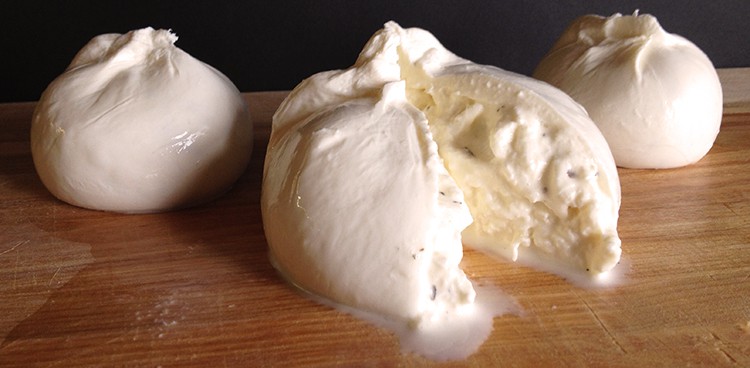
To me, most cheese is a fairy tale. It’s a tale of magic and imagination, danger and risk, comfort and protection, and in the end, a true love to live with happily ever after. Burrata is no exception.
Rags to Riches
As I piece together the origins of burrata, a scene from Disney’s Cinderella comes to mind. In the scene, Cinderella runs to the garden, her dress tattered and torn and her fairy godmother waves a magic wand turning a pumpkin into a stagecoach and the scraps of her dress into a glimmering, gorgeous ball gown.
Around the 1920s in the Italian region of Puglia, a similar thing happened with cheese. No fairy godmother (though, we could argue a godfather was involved), but a cheesemaker did take scraps and turn them into something glimmering and gorgeous: burrata.
The maker melted and whipped curd scraps (called stracciatelle, or “rags”) from mozzarella production, then dropped them into the hollow cavities of larger balls of fresh mozzarella—turning what would have been waste into a rich, creamy filling and a regular cheese into the belle of the ball.
For the finishing touch, these new, delicate balls of cheese were traditionally wrapped in asphodel leaves (a relative of the leek) before being sold.
Getting to the Ball
Burrata, though unique for its filling, still falls into the pasta filata category of cheeses. Similar to string cheese, mozzarella and Queso Oaxaca the milk is heated, curdled, cut, re-heated, and then stretched into the final cheese form.
The process of re-heating and stretching is a delicate one. The curds must be heated enough to stretch but not so hot that they burn. This temperature is usually between 180° and 190°F. (Hot!) The next steps must be approached with firm, careful hands: The hot curds need to be pressed and kneaded until they melt together into a smooth, solid, pliable mass. Then the art of stretching and shaping comes into play. The pliable cheese is taken to a next level of light airiness as the maker pulls and forms the curds—careful not to work it too much—into a variety of shapes, depending on the cheese.
In regular mozzarella, curds are stretched and formed into a solid ball. For burrata, the curds are stretched into sheets that are formed into the pouch that holds the stracciatelle and, sometimes, extra cream.
After the pouch is filled with the creamy goodness, it’s sealed off with a light twist and dropped into cooler (i.e., close to room temperature) water to rest. This helps set the forms and lock in the gooey insides.
Once the burrata is rested, it’s ready to eat!

Finally, the Dance
A fresh cheese, burrata is best eaten soon after it’s made. But if you’re not in close vicinity to a buratta resting tank, you’ll just want to get it as soon as possible.
When you do finally have that little ball of buttery, milky joy, what do you do with it?
Recipes and pairings are seemingly endless. This cheese works in salads, in meat dishes, for breakfast, and more, but sometimes simpler is just enough. A ball of burrata, cut into thick wedges (it’s a little too creamy to slice any other way), drizzled with olive oil, salt, and pepper, and placed on a slice of baguette… dreamy, dreamy, creamy magic.
Where can I find it?
Though newer to America, burrata is making cheese-dreams come true across the country. Here are a few great balls of burrata.
For the traditional, fresh milky flavor:
For a little something special:
- BelGioioso Black Truffle
- Fiore di Nonno Lavendar Honey with Chili
- Maplebrook Farms Herb




